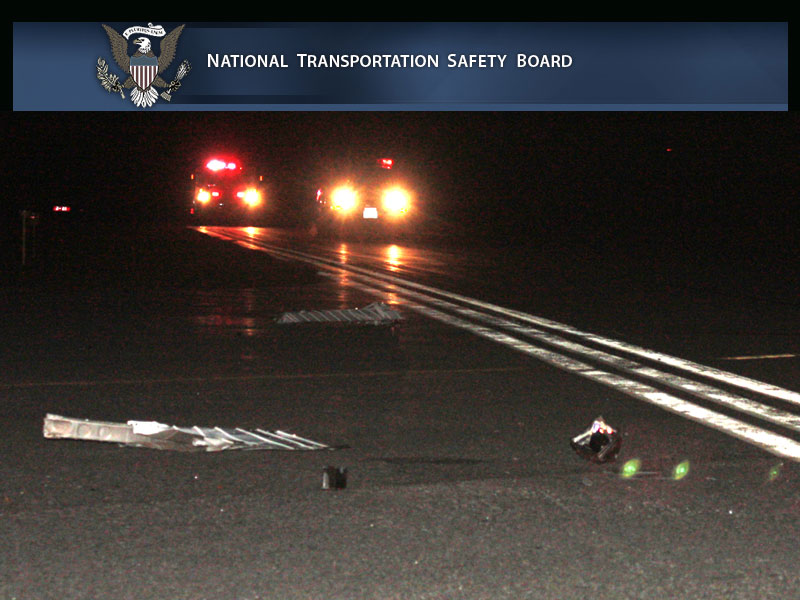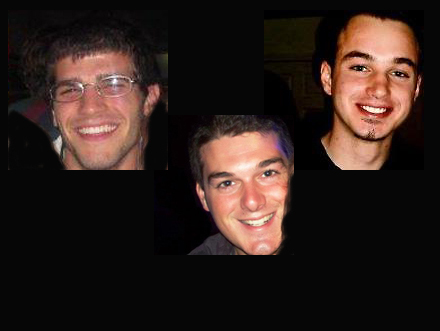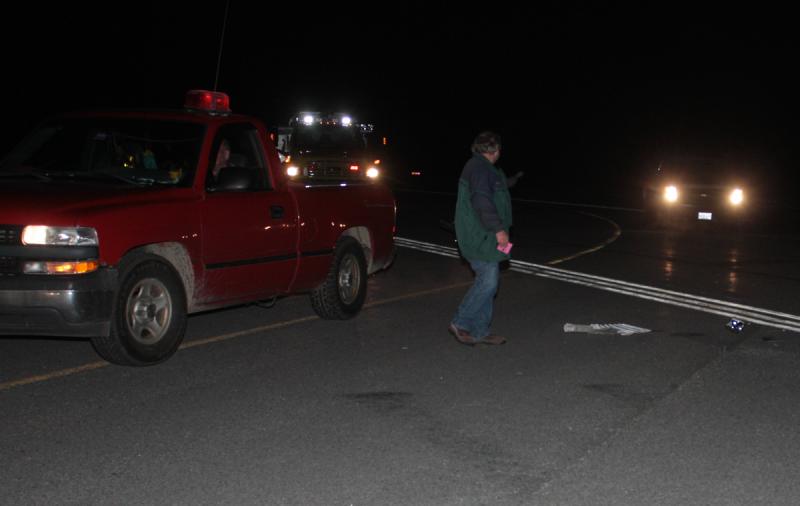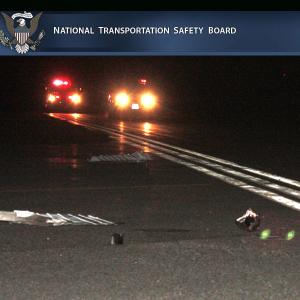NTSB finds pilot, truck’s driver both contributed to fatal 2012 plane crash in Owls Head
 Debris and parts from the collision of 1994 GMC Sonoma pickup truck with the private Cessna airplane on runway on the night of Nov. 16, 2012. The pilot and two passengers were killed in the crash, after which the airplane caught fire. The truck’s driver was uninjured. (Photo by Holly S. Edwards)
Debris and parts from the collision of 1994 GMC Sonoma pickup truck with the private Cessna airplane on runway on the night of Nov. 16, 2012. The pilot and two passengers were killed in the crash, after which the airplane caught fire. The truck’s driver was uninjured. (Photo by Holly S. Edwards)
 Left top: David Cheney of Beverly, Mass.; right top: Marcelo Rugini of Brazil; center bottom: William Hannigan III of South Portland. (Photos courtesy Facebook)
Left top: David Cheney of Beverly, Mass.; right top: Marcelo Rugini of Brazil; center bottom: William Hannigan III of South Portland. (Photos courtesy Facebook)
 Airport manager Jeff Northgraves at the location where the plane, taking off at speeds of 70 mph, crashed into the pickup truck crossing the runway. (Photo by Holly S. Edwards)
Airport manager Jeff Northgraves at the location where the plane, taking off at speeds of 70 mph, crashed into the pickup truck crossing the runway. (Photo by Holly S. Edwards)
 After striking the pickup truck, driven by Stephen Turner, 62, of Camden, on the runway at Knox County Regional Airport, the small Cessna lost control, crashed into the woods and caught fire. (Photo courtesy Steve Waterman)
After striking the pickup truck, driven by Stephen Turner, 62, of Camden, on the runway at Knox County Regional Airport, the small Cessna lost control, crashed into the woods and caught fire. (Photo courtesy Steve Waterman)
 Debris and parts from the collision of 1994 GMC Sonoma pickup truck with the private Cessna airplane on runway on the night of Nov. 16, 2012. The pilot and two passengers were killed in the crash, after which the airplane caught fire. The truck’s driver was uninjured. (Photo by Holly S. Edwards)
Debris and parts from the collision of 1994 GMC Sonoma pickup truck with the private Cessna airplane on runway on the night of Nov. 16, 2012. The pilot and two passengers were killed in the crash, after which the airplane caught fire. The truck’s driver was uninjured. (Photo by Holly S. Edwards)
 Left top: David Cheney of Beverly, Mass.; right top: Marcelo Rugini of Brazil; center bottom: William Hannigan III of South Portland. (Photos courtesy Facebook)
Left top: David Cheney of Beverly, Mass.; right top: Marcelo Rugini of Brazil; center bottom: William Hannigan III of South Portland. (Photos courtesy Facebook)
 Airport manager Jeff Northgraves at the location where the plane, taking off at speeds of 70 mph, crashed into the pickup truck crossing the runway. (Photo by Holly S. Edwards)
Airport manager Jeff Northgraves at the location where the plane, taking off at speeds of 70 mph, crashed into the pickup truck crossing the runway. (Photo by Holly S. Edwards)
 After striking the pickup truck, driven by Stephen Turner, 62, of Camden, on the runway at Knox County Regional Airport, the small Cessna lost control, crashed into the woods and caught fire. (Photo courtesy Steve Waterman)
After striking the pickup truck, driven by Stephen Turner, 62, of Camden, on the runway at Knox County Regional Airport, the small Cessna lost control, crashed into the woods and caught fire. (Photo courtesy Steve Waterman)
WASHINGTON, D.C. — The National Transportation Safety Board Friday released its report into the single-engine plane crash at Knox County Airport in Owls Head in November 2012, coming to a determination that both the pilot and airport personnel contributed to the accident that killed the private pilot and two passengers.
According to the NTSB report, dated May 8, 2014, the probable cause was: "The vehicle driver's failure to verify that the runway was not occupied by an airplane before crossing the runway, which resulted in the vehicle being struck by a departing airplane, and the pilot's continued takeoff with flight control damage, which subsequently results in an aerodynamic stall and spin at law altitude."
At around 4:45 p.m. on Nov. 16, 2012, Stephen Turner, 62, of Camden, was driving his private service truck on the taxiway and followed another aircraft out to a taxiway. The other airplane continued down the taxiway and Turner told investigators he proceeded with his vehicle to the "hold short line" of the runway and announced his intentions on the common traffic advisory frequency using the radio in his truck. Hearing no response and not seeing anything on the runway, Turner said as he proceeded forward to cross runway 31, a "blur of an object" went by in front of him, striking the front of his truck.
According to the report, Turner continued to cross the runway and then got out to inspect what he saw, at which time he observed an airplane attempting to climb. He continued watching the airplane drift to the left of runway 31 and then make a left turn, as if attempting to return to the airport.
"Subsequently, the airplane was then observed in 'slow flight' and then it began to spin. He observed the airplane on fire as he was driving to the accident scene. He also noticed while driving that his headlights were not working now," said the report.
According to an eyewitness statement, the airplane was observed departing to the west and appeared to be doing a left climbing "chandelle," or abrupt turn, type maneuver. The airplane also had what appeared to be a "high angle of attack." About 200 feet above ground level, when navigation level lights were observed rotating slowly counter clockwise, the airplane appeared to pitch down and was observed descending behind trees.
The pilot of the airplane was identified in 2012 as 24-year-old William "B.J." Hannigan III of South Portland. He held a private pilot certificate with a rating for airplane single-engine land. His passengers were David Chaney, 22, of Beverly, Mass., and Marcelo Rugini, 24, a foreign exchange student living in Nobleboro, who was from Mulitermo, Rio Grande do Sul, Brazil.
All three men were Lambda Chi Alpha fraternity members and attended University of Maine at Orono. Chaney was currently the fraternity's president and a business major and Rugini was an economics major. Hannigan graduated from UMaine in 2011 with a bachelor's degree in civil engineering.
Turner was not injured in the crash.
Knox County Regional Airport is a publicly-owned airport and at the time of the accident, did not have an operating control tower. The airport was equipped with two runways, designated as runway 13/31 and 03/21, and both were reported as "in good condition" at the time.
According to the report, photos and video were produced about the time of the accident the following day in similar cloud conditions, which were clear with 20 miles of visibility.
"From the threshold of runway 31 with the lights of an airport operations vehicle, parked on taxiway "A" could be detected with only the use of the vehicle's headlights; however, when the airport runway and taxiway lights were illuminated to the full bright position the vehicle lights were unable to be differentiated from the surrounding lights," said the report.
An inspection of the vehicle found that it exhibited damaged along the front, including the headlights and grill. The truck also had an impact mark along the left tire well, located approximately 26 inches above the ground and the impact mark was similar in size as the right elevator.
"A light bulb from one headlamp was located and the filament was stretched similar to being utilized.... According to the owner of the vehicle, it did not have nor has he ever used a yellow airport flashing light," said the report.
Upon reviewing the aircraft, it was determined it impacted the ground nose down, approximately 70 degrees, inverted altitude. The left wing came to rest inverted and the right wing and cockpit came to rest right side up. The wreckage was located approximately 2,100 feet from the initial impact with the vehicle.
The taxi light and landing light were destroyed in the crash and subsequent fire that also damaged the engine and cockpit. No conclusive evidence could be obtained from the strobe lights on the wings as to their operation at ground impact, and while the autopilot servo cables remained intact and secured to the aileron cables, operation of the autopilot could not be determined.
The review of the aircraft found paint transfer marks on the right elevator, which are best described as adjustable flaps at the back of the plane and below the rudder. Those paint marks were determined to be associated with Turner's truck.
The cockpit of the aircraft was consumed by post-impact fire, with the directional gyro the only instrument that was recognizable, though no notable information could be obtained due to fire damage. Three seat belt latches were located and buckled, but fire destroyed evidence of the seat belt webbing. Investigators were also unable to locate a shoulder harness, and no shoulder harness straps were buckled to the lap belt buckle.
An autopsy of Hannigan was performed Nov. 18, 2012, by the state Medical Examiner's Office in Augusta, and listed the cause of death as multiple blunt injuries. Forensic toxicology tests found no carbon monoxide, and no cyanide or ethanol detected in the blood.
The report cited the Federal Aviation Administration's Airplane Flying Handbook as it pertains to "Takeoffs and Departure Climbs" and cited the part that read, "Rejected Takeoff/Engine Failure. Emergency or abnormal situations can occur during a takeoff that will require a pilot to reject the takeoff while still on the runway. Circumstances such as a malfunctioning powerplant, inadequate acceleration, runway incursion or air traffic conflict may be reasons for a rejected takeoff. Prior to takeoff, the pilot should have in mind a point along the runway at which the airplane should be airborne. If that point is reached and the airplane is not airborne, immediate action should be taken to discontinue the takeoff. Properly planned and executed, chances are excellent the airplane can be stopped on the remaining runway without using extraordinary measure..."
The handbook also notes that night flying demands more attention of the pilot... "The most noticeable difference is the limited availability of outside visual references. Therefore, the flight instruments should be sued to a greater degree in controlling the airplane. This is particularly true on night takeoffs and climbs. The cockpit lights should be adjusted to a minimum brightness that will allow the pilot to read the instruments and switches and yet not hinder the pilot's outside vision...."
The report also cited the Knox County Regional Airport Flightline Driving Manual , which states, in part, that vehicles must obtain prior authorization from airport management and must have and monitor the airport's radio frequency at all times before entering/driving on any aircraft movement area.
It goes on to quote: "When driving on an airport operations area make sure your vehicle is properly equipped for the area where you operate, i.e., radio, beacon, markings... use extreme caution at night and/or in poor weather conditions...aircraft always have the right of way..."
In its findings, the NTSB determined:
1. Cause due to personnel issues: Incorrect action performance on the part of the pilot.
2. Cause due to personnel issues: Lack of action of the part of airport personnel
3. Cause due to the aircraft (performance): Pitch control not attained/maintained
4. Factor due to environmental issue: Light conditions contributed to the outcome.
The NTSB noted that the truck's driver stated he did not, nor was ever required to have, a yellow beacon on his vehicle.
"After the accident, the airport required airport beacons to be placed on the top most portion of the vehicle and to be operational both day and night while that vehicle operates on the ramp, taxiway, runway or any other areas that an aircraft may operate," said the report.
The NTSB's report also said that it could not be determined if the driver or pilot announced their intentions over the airport common traffic advisory frequency.
"A handheld radio was located on the vehicle's dashboard, however it was found in the 'off' position. When the radio was placed in the 'on' position and the correct frequency was set, the radio transmitted and received with no anomalies noted," said the report. "Although the airplane was close to or perhaps past lift-off speed, the pilot likely could have stopped the airplane on the remaining 3,600-feet of paved runway following the impact with the vehicle. However, the pilot did not discontinue the takeoff."
NTSB reports:
Related stories:
• Plane down at Owls Head (posted Nov. 16, 2012, 5:15 p.m.)
• Truck on runway causes Owls Head plane crash, three killed (posted Nov. 17, 5:45 p.m.)
• University of Maine identifies three killed in Owls Head plane crash (posted Nov. 17, 10:30 p.m.)
Editorial Director Holly S. Edwards can be reached at hollyedwards@penbaypilot.com or 706-6655.
Event Date
Address
United States
































